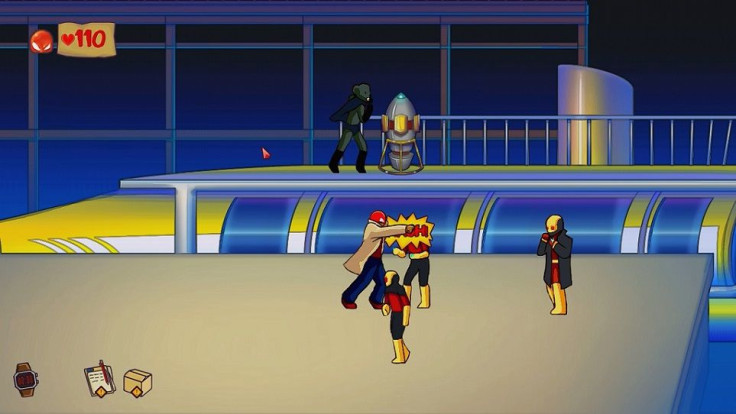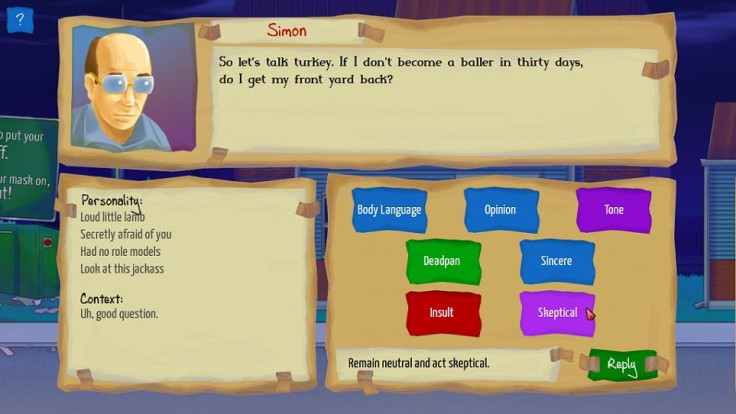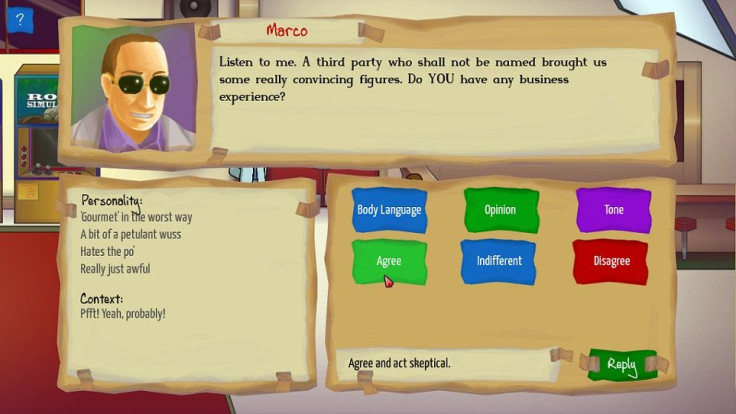Any longtime professional wrestling fan can tell you that adjusting to life after in-ring action seems to be a problem for many in the industry. That struggle is even the premise of an excellent Darren Aronofsky film, The Wrestler, which offered a glimpse of life after in-ring action for one fictitious performer.
Will Fight For Food: Super Actual Sellout: Game Of The Hour looks to tell a similar story, with a bit more humor, via a two-dimensional brawler that breaks genre conventions by also allowing players to have detailed conversations with every NPC in the game. In fact, the entire Will Fight For Food story can be completed without ever throwing a punch. Or without ever speaking a word. The choice is yours.
We spoke with Arvind Yadav, team lead, programmer and game designer for Will Fight For Food, and it turns out Pyrodactyl's next project has some inspirations that you might not expect. And, as one-fifth of the entire Will Fight For Food team, Yadav was able to offer quite a bit of insight into the process of bringing WFFF to life, along with the challenges facing an independent dev team whose members live thousands of miles apart.
"I was a big fan of professional wrestling," Yadav explained, when asked about the inspiration behind the game's elaborate conversation system. "At the same time, I was also very into role-playing games. You know, Baldur's Gate, that kind of thing … and the charming thing about wrestling, to me, was the talking and bullshitting around it. The drama. So, I figured it would be interesting to take the standard RPG template and apply wrestling sensibilities to it. "
In Will Fight For Food, players assume control of former luchador Jared Dent; one of eight amateur wrestlers now struggling to deal with the real world after retiring from in-ring action. Each struggles with a different aspect of their post-wrestling existence, including Jared, and it will be up to WFFF players to assist (or antagonize) each member of the troupe.

"The closest equivalent is Double Dragon 3. It's very retro. It's not like the WWE games," Yadav said.. "If you're a fan of those 2D NES brawlers, then you'll definitely recognize almost all of the moves."
Of course, while combat might feel familiar to those who spent their childhood playing Battletoads, Double Dragon or Kung Fu Master, Will Fight For Food draws plenty of inspiration from both tabletop and computer-based role-playing games, too. Even current storylines in the WWE capture Arvind’s interest.
In the weeks leading up to WrestleMania 31, WWE performer Seth Rollins had a brief on-screen spat with The Daily Show host Jon Stewart. The "beef' began on an episode of WWE Raw, before escalating online and via Stewart's nightly broadcast, culminating with a staged encounter between the two on WWE programming. But it was the way in which each performer, one a former comedian and the other a pro wrestler, addressed the crowd that caught the Will Fight For Food designer's attention.
“When I see these people in the ring, I think, 'What are they doing apart from the talking?'" Yadav said. "Look at how Stewart's body language was completely different from Rollins' … at some point, it doesn't matter what the wrestler says. It's how they say it.”

What ultimately sets Will Fight For Food: Super Actual Sellout: Game Of The Hour apart from other brawlers-- other than that mouthful of a name -- is that the 2D action-adventure can be completed without ever committing an act of violence. Sure, you could punch you way from the first screen to the credits. But the real draw of Will Fight For Food is the conversation system at the heart of the game.
Each time you speak to another WFFF character, players must decide on Jared's body language, tone of voice and actual opinion on the matter(s) being discussed. The choices must be registered regardless of which dialogue option you've chosen, and your non-verbal communication (in many cases) will matter just as much as the player's word selection.
With a team that prefers such open-ended gameplay, Pyrodactyl looks at combat as a single tool in the player's arsenal; just one of many potential solutions that players aren't forced to rely on regularly. Most players will probably resort to fisticuffs at some point in their Will Fight Food playthrough. But WFFF will have plenty of "action" for those who'd prefer to navigate the intricacies of conversation, instead.
"Somebody in a tabletop RPG session might want to spend the entire two or three hours just talking to everyone in the inn," Yadav said. "Or say they're fighting in a dungeon and come across a library. A player might pick up the book and ask [the Dungeon Master], 'What does it say?'"
Conversely, the WFFF designer says that anyone who gets bored of the standard town-quest-town rotation can simply subvert it with "good, old-fashioned professional wrestling."

Similarly, the order in which you resolve the issues of Dent's fellow retirees is left entirely up to the player. Everyone's issues must be dealt with, along with those of a handful of other retired wrestlers, in part because players' solutions dictate which of the game's conclusions they'll see. There are only a few potential endings but each should make sense in the context of players' actions.
In some ways, Will Fight For Food looks to be a similar experience to Pyrodactyl's last public release, Unrest. Granted, the former's emphasis on non-verbal communication puts some distance between it and Pyrodactyl's last Steam release. But there's apparently good reason for that perceived commonality.
"Unrest [has] a serious tone. So, it has a lot of complex stories, realistic characters, politics and all of that stuff," Yadav told iDigi. "Then we had the chance to put everything we learned with Unrest back into Will Fight For Food … the games weren't developed in parallel but they kind of exist alongside each other."
According to Yadav, the two projects have existed in-tandem since 2011, though Will Fight For Food was the first to see actual development. The team distributed an early version of WFFF while completing Unrest, a period in which they also submitted Will Fight For Food to Steam Greenlight.

Once it was clear that the project had legs, Pyrodactyl set to work expanding upon the original concept and fleshing out the conversation system that will be featured in Will Fight For Food when it launches on April 22.
Now, four years after work first began on the project, the Will Fight For Food: Super Actual Sellout: Game Of The Hour team is counting down the days until it's second game debuts on Steam. It'll be weeks before they know whether or not all the extra effort on WFFF will amount to much, or if the gaming community just has an appetite for conversation-focused 2D brawlers. But there's no question, at least to Yadav, about whether or not the team can continue to produce new and interesting projects. Even with the Pyrodactyl crew scattered across three continents.
"It's not a studio in the traditional sense, but we've been making games for six or seven years now," Yadav said confidently. His only concession: "Team meetings are pretty tough."
Be sure to check back with iDigitalTimes.com and follow Scott on Twitter for additional Will Fight For Food: Super Actual Sellout: Game Of The Hour coverage, including our review of the game, for however long Pyrodactyl continues to support Will Fight For Food after launch.
Were you already familiar with Will Fight For Food: Super Actual Sellout: Game Of The Hour? Not sure what to think of the game's focus on non-verbal communication? Excited to check out WFFF when the game heads to Steam later this month?
Let us know in the comments section!


















